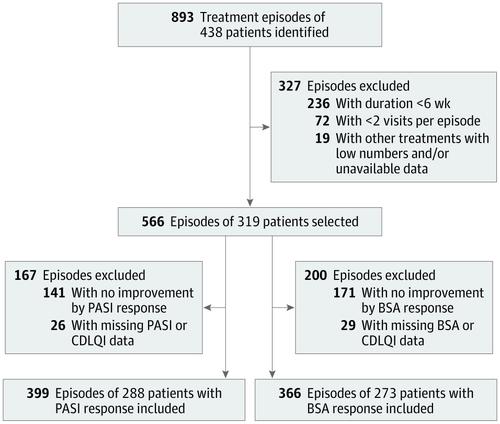当前位置:
X-MOL 学术
›
JAMA Dermatol.
›
论文详情
Our official English website, www.x-mol.net, welcomes your
feedback! (Note: you will need to create a separate account there.)
Association Between Quality of Life and Improvement in Psoriasis Severity and Extent in Pediatric Patients.
JAMA Dermatology ( IF 11.5 ) Pub Date : 2019-11-27 , DOI: 10.1001/jamadermatol.2019.3717 Finola M Bruins 1 , Inge M G J Bronckers 1 , Hans M M Groenewoud 2 , Peter C M van de Kerkhof 1 , Elke M G J de Jong 1 , Marieke M B Seyger 1
JAMA Dermatology ( IF 11.5 ) Pub Date : 2019-11-27 , DOI: 10.1001/jamadermatol.2019.3717 Finola M Bruins 1 , Inge M G J Bronckers 1 , Hans M M Groenewoud 2 , Peter C M van de Kerkhof 1 , Elke M G J de Jong 1 , Marieke M B Seyger 1
Affiliation

|
Importance
Treatment of psoriasis is associated with improved quality of life (QOL) in those with the disease. However, in daily clinical practice, the association between the degree of psoriasis clearance and QOL has not been studied to date, especially in the pediatric population.
Objectives
To identify the association between the degree of psoriasis improvement (as measured by the Psoriasis Area Severity Index [PASI] and body surface area [BSA] response) and QOL (as measured by the Children's Dermatology Life Quality Index [CDLQI]) in pediatric psoriasis, and to assess the association of treatment type with QOL, independent of psoriasis improvement.
Design, Setting, and Participants
Data used in this single-center cohort study were extracted from the Child-CAPTURE (Continuous Assessment of Psoriasis Treatment Use Registry), a prospective, observational, daily clinical practice cohort of all children (aged <18 years) with a psoriasis diagnosis who attended the outpatient clinic of the Department of Dermatology at the Radboud University Medical Center in Nijmegen, the Netherlands, between September 3, 2008, and May 4, 2018. All records of treatment episodes with CDLQI, PASI, and BSA scores were included in the analysis.
Exposures
Patients were treated according to daily clinical care. Treatments were clustered into topical, dithranol, conventional systemic, and biological treatments. Because of low numbers of UV-B phototherapy, this treatment was not assessed.
Main Outcomes and Measures
Primary outcomes were mean change of CDLQI scores per PASI and BSA response categories (0 to <50, 50 to <75, 75 to <90, and ≥90) and mean CDLQI change per treatment categories.
Results
In total, 319 patients (median [interquartile range] age, 10.0 [7.0] years; 183 female [57.4%]) were analyzed for PASI score improvement (399 treatment episodes) and improvement in BSA involvement (366 treatment episodes). The greatest improvements in CDLQI scores were seen in the PASI ≥90 response category, with an estimated marginal mean change in CDLQI score of -6.6 (95% CI, -7.5 to -5.7). The greatest improvements in CDLQI scores were also observed in the BSA ≥90 response category, with an estimated marginal mean change in CDLQI score of -6.8 (95% CI, -7.5 to -6.1). Systemic treatment demonstrated a greater degree of improvement of CDLQI compared with topical treatment, independent of PASI response categories.
Conclusions and Relevance
This cohort study in a real-world setting found that the greatest improvements in QOL were associated with PASI 90 or greater, a decrease in BSA involvement of 90% or greater, and systemic treatments. These findings suggest that reaching PASI 90 or greater and decreasing BSA involvement by at least 90% may be clinically meaningful treatment goals that will help pediatric patients with psoriasis reach optimal QOL.
中文翻译:

生活质量与小儿牛皮癣严重程度和程度的改善之间的关联。
牛皮癣的重要治疗与患有这种疾病的人的生活质量(QOL)改善有关。但是,迄今为止,在日常临床实践中,尤其是在儿科人群中,尚未研究银屑病清除率与QOL之间的关系。目的确定儿童银屑病改善程度(通过银屑病面积严重性指数[PASI]和体表面积[BSA]反应测量)与QOL(通过儿童皮肤病生活质量指数[CDLQI]测量)之间的关联牛皮癣,并评估治疗类型与QOL的相关性,独立于牛皮癣的改善。设计,设置和参与者本单中心队列研究中使用的数据摘自儿童前瞻性研究(儿童捕获)(银屑病治疗使用注册的持续评估),在2008年9月3日至5月4日期间,在荷兰奈梅亨的拉德布德大学医学中心皮肤科门诊就诊的所有患有牛皮癣的儿童(年龄小于18岁)的观察性,日常临床实践队列,2018年。分析中包括所有具有CDLQI,PASI和BSA评分的治疗发作记录。暴露根据日常临床护理对患者进行治疗。治疗方法分为局部治疗,二乙醇胺治疗,常规全身治疗和生物治疗。由于UV-B光疗的数量较少,因此未评估该治疗。主要结果和措施主要结果是每个PASI和BSA响应类别(0至<50、50至<75、75至<90和≥90)的CDLQI得分平均变化,以及每个治疗类别的平均CDLQI变化。结果共分析了319例患者(中位[四分位数间距],10.0 [7.0]岁; 183位女性[57.4%])的PASI评分改善(399次治疗发作)和BSA感染改善(366次治疗发作)。在PASI≥90的反应类别中,CDLQI分数的改善最大,估计的CDLQI分数的边际平均变化为-6.6(95%CI,-7.5至-5.7)。在BSA≥90的响应类别中,也观察到CDLQI得分的最大改善,估计CDLQI得分的边际平均变化为-6.8(95%CI,-7.5至-6.1)。与局部治疗相比,全身治疗显示CDLQI改善程度更高,而与PASI反应类别无关。结论与相关性这项队列研究在现实世界中发现,QOL的最大改善与PASI 90或更高,BSA参与度降低90%或更高以及全身治疗有关。这些发现表明,达到PASI 90或更高并减少至少90%的BSA参与可能是具有临床意义的治疗目标,这将帮助患有牛皮癣的小儿患者达到最佳QOL。
更新日期:2020-01-08
中文翻译:

生活质量与小儿牛皮癣严重程度和程度的改善之间的关联。
牛皮癣的重要治疗与患有这种疾病的人的生活质量(QOL)改善有关。但是,迄今为止,在日常临床实践中,尤其是在儿科人群中,尚未研究银屑病清除率与QOL之间的关系。目的确定儿童银屑病改善程度(通过银屑病面积严重性指数[PASI]和体表面积[BSA]反应测量)与QOL(通过儿童皮肤病生活质量指数[CDLQI]测量)之间的关联牛皮癣,并评估治疗类型与QOL的相关性,独立于牛皮癣的改善。设计,设置和参与者本单中心队列研究中使用的数据摘自儿童前瞻性研究(儿童捕获)(银屑病治疗使用注册的持续评估),在2008年9月3日至5月4日期间,在荷兰奈梅亨的拉德布德大学医学中心皮肤科门诊就诊的所有患有牛皮癣的儿童(年龄小于18岁)的观察性,日常临床实践队列,2018年。分析中包括所有具有CDLQI,PASI和BSA评分的治疗发作记录。暴露根据日常临床护理对患者进行治疗。治疗方法分为局部治疗,二乙醇胺治疗,常规全身治疗和生物治疗。由于UV-B光疗的数量较少,因此未评估该治疗。主要结果和措施主要结果是每个PASI和BSA响应类别(0至<50、50至<75、75至<90和≥90)的CDLQI得分平均变化,以及每个治疗类别的平均CDLQI变化。结果共分析了319例患者(中位[四分位数间距],10.0 [7.0]岁; 183位女性[57.4%])的PASI评分改善(399次治疗发作)和BSA感染改善(366次治疗发作)。在PASI≥90的反应类别中,CDLQI分数的改善最大,估计的CDLQI分数的边际平均变化为-6.6(95%CI,-7.5至-5.7)。在BSA≥90的响应类别中,也观察到CDLQI得分的最大改善,估计CDLQI得分的边际平均变化为-6.8(95%CI,-7.5至-6.1)。与局部治疗相比,全身治疗显示CDLQI改善程度更高,而与PASI反应类别无关。结论与相关性这项队列研究在现实世界中发现,QOL的最大改善与PASI 90或更高,BSA参与度降低90%或更高以及全身治疗有关。这些发现表明,达到PASI 90或更高并减少至少90%的BSA参与可能是具有临床意义的治疗目标,这将帮助患有牛皮癣的小儿患者达到最佳QOL。











































 京公网安备 11010802027423号
京公网安备 11010802027423号